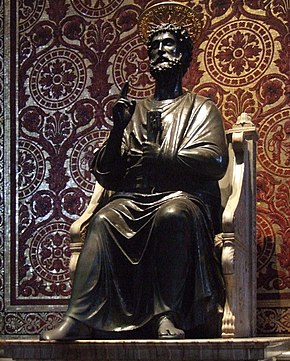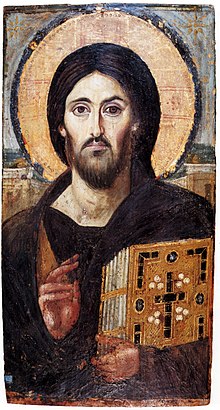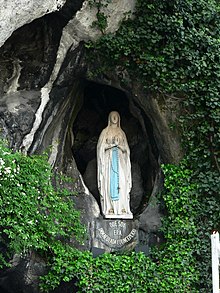Dogma in the Catholic Church

A dogma of the Catholic Church is defined as "a truth revealed by God, which the magisterium of the Church declared as binding".[1] The Catechism of the Catholic Church states:
The Church's Magisterium asserts that it exercises the authority it holds from
Christ to the fullest extent when it defines dogmas, that is, when it proposes, in a form obliging Catholics to an irrevocable adherence of faith, truths contained in divine Revelation or also when it proposes, in a definitive way, truths having a necessary connection with these.[2]
The faithful are only required to accept a teaching as dogma if the Catholic Church clearly and specifically identifies them as dogmas.[1]
Elements: Scripture and tradition
The concept of dogma has two elements: 1) the
Dogma as divine and Catholic faith
| Part of a series on the |
| Catholic Church |
|---|
 |
| Overview |
|
|
A dogma implies a twofold relation: to
A dogma's "strict signification is the object of both
At the turn of the 20th century, a group of theologians called
However, truths of the faith have been declared dogmatically throughout the ages. The instance of a Pope doing this outside an Ecumenical Council is rare, though there were two instances in recent times: the
Early uses of the term
The term Dogma Catholicum was first used by
It is Catholic teaching that, with Christ and the Apostles, revelation was complete. Dogmas issued after the death of his apostles are not new, but explications of existing faith. Implicit truths are specified as explicit, as was done in the teachings on the Trinity by the ecumenical councils. Karl Rahner tries to explain this with the allegorical sentence of a husband to his wife, "I love you"; this surely implies, I am faithful to you.[13] In the 5th century Vincent of Lérins wrote, in Commonitory, that there should be progress within the church,
on condition that it be real progress, not alteration of the faith. For progress requires that the subject be enlarged in itself, alteration, that it be transformed into something else. The intelligence, then, the knowledge, the wisdom, [...] of individuals [...] as well of [...] the whole Church, ought, in the course of ages and centuries, to increase and make much and vigorous progress; but yet only in its own kind; that is to say, in the same doctrine, in the same sense, and in the same meaning.[14]
Vincent commented on the First Epistle to Timothy (6:20) that Timothy, for Vincent, represented "either generally the Universal Church, or in particular, the whole body of The Prelacy", whose obligation is "to possess or to communicate to others a complete knowledge of religion" called the deposit of faith. According to Vincent, the deposit of faith was entrusted and not "devised: a matter not of wit, but of learning; not of private adoption, but of public tradition." Vincent expounded that you "received gold, give gold in turn," and not a substitute or a counterfeit. Vincent explained that those who are qualified by a "divine gift" should "by wit, by skill, by learning" expound and clarify "that which formerly was believed, though imperfectly apprehended" – to understand "what antiquity venerated without understanding" and teach "the same truths" in a new way.[15] The church uses this text in its interpretation of dogmatic development. In 1870, the First Vatican Council quoted from Commonitory and stated, in the dogmatic constitution Dei Filius, that "meaning of the sacred dogmas is perpetually to be retained" once they have been declared by the Catholic Church and "there must never be a deviation from that meaning on the specious ground and title of a more profound understanding."[16][17] In 1964, the Second Vatican Council further developed this in Lumen Gentium.[18][a]
Classification
According to Catholic theologian Ludwig Ott:[19]
Dogmas are classified:
a) According to their content as: General Dogmas (dogmata generalia) and Special Dogmas (dogmata specialia). To the former belong the fundamental truths of Christianity, to the latter the individual truths contained therein.
b) According to their relation with Reason as: Pure Dogmas (dogmata pura) and Mixed Dogmas (dogmata mixta). The former we know solely through
Natural Reason also, e.g., The Existence of God.c) According to the mode by which the Church proposes them, as: Formal Dogmas (dogmata formalia) and Material Dogmas (dogmata materialia). The former are proposed for belief by the Teaching Authority of the Church as truths of Revelation; the latter are not so proposed, for which reason they are not Dogmas in the strict sense.
d) According to their relation with salvation as: Necessary Dogmas (dogmata necessaria) and Non-necessary Dogmas (dogmata non-necessaria). The former must be explicitly believed by all in order to achieve eternal salvation; for the latter implicit faith (fides implicita) suffices (cf. Hebr. II, 6).
Theological certainty
The magisterium of the church is directed to guard, preserve and teach divine truths which God has revealed with
Examples of dogmatic definitions
Ecumenical councils
- Nicaea I: divine filiation[22]
- Mother of God[23]
- Chalcedon: Jesus is true man, with a human body and a human soul[24]
- Constantinople: Jesus is true God and has a human will and a divine will[25]
- Nicaea II: holy images may be created and are owed veneration, not adoration[26]
- Vatican I: papal infallibility[27]
Council of Trent
The Council of Trent made a number of dogmatic definitions about the sacraments and other beliefs and practices of the church, such as the following:
- transubstantiation[28]
- purgatory[29]
- seal ("secret") of the sacrament of Confession is inviolable[30]
- polygamy is a sin[31]
Ex cathedra
- Pius IX: Immaculate Conception of Mary[32]
- Pius XII: Assumption of Mary[33]
Papal bulls and encyclicals

Pope Pius XII stated in Humani generis that papal encyclicals, even when they are not ex cathedra, can nonetheless be sufficiently authoritative to end theological debate on a particular question:
Nor must it be thought that what is expounded in Encyclical Letters does not of itself demand consent, since in writing such Letters the Popes do not exercise the supreme power of their Teaching Authority. For these matters are taught with the ordinary teaching authority, of which it is true to say: "He who heareth you, heareth me" (Luke 10:16); and generally what is expounded and inculcated in Encyclical Letters already for other reasons appertains to Catholic doctrine. But if the Supreme Pontiffs in their official documents purposely pass judgment on a matter up to that time under dispute, it is obvious that that matter, according to the mind and will of the Pontiffs, cannot be any longer considered a question open to discussion among theologians.[34]
The end of the theological debate is not identical, however, with dogmatization. Throughout the history of the church, its representatives have discussed whether a given papal teaching is the final word or not.
In 1773,
In 1995, questions arose as to whether the
Critics of Ordinatio Sacerdotalis point out, though, that it was not promulgated under the
Apparitions and revelations

The Catholic Church distinguishes between the apparitions within divine revelation – such as the risen Jesus' apparitions to the Apostles and the sign of the woman in the
While
Ecumenical aspects
Protestant theology since the reformation was largely negative on the term dogma. This changed in the 20th century, when Karl Barth in his book Kirchliche Dogmatik stated the need for systematic and binding articles of faith.[40]
The
See also
- Catholic dogmatic theology
- Catholic Mariology#Dogmatic teachings
- Enchiridion symbolorum, definitionum et declarationum de rebus fidei et morum
- Dogmatic fact
Notes
- ^ "The entire body of the faithful [...] cannot err in matters of belief" when the people of God manifests "discernment in matters of faith when [...] they show universal agreement in matters of faith and morals." That discernment "is exercised under the guidance of the sacred teaching authority, in faithful and respectful order to which the people of God accepts that which is not just the word of men but truly the word of God. Through it, the people of God adheres [...] to the faith given once and for all to the saints, penetrates it more deeply with right thinking, and applies it more fully in its life."[18]
- ^ Christian faith cannot accept "revelations" that claim to surpass or correct the Revelation of which Christ is the fulfillment as is the case in certain non-Christian religions and also in certain recent sects which base themselves on such "revelations".[37]
- ^ "The Christian economy, therefore, since it is the new and definitive Covenant, will never pass away; and no new public revelation is to be expected before the glorious manifestation of our Lord Jesus Christ." Yet even if god permits no new revelations, it has not been made completely explicit; it remains for Christian faith gradually to grasp its full significance over the course of the centuries.[38]
- ^ Tradition is to be distinguished from the various theological, disciplinary, liturgical or devotional traditions, born in the local churches over time. These are the particular forms, adapted to different places and times, in which the great Tradition is expressed. In the light of Tradition, these traditions can be retained, modified or even abandoned under the guidance of the church's magisterium.[39]
- ^ Additional dogmas are in part precisation of clauses contained in the creed. However this may be, all of them follow technically from the clause "and the One, Holy, Catholic and Apostolic Church", in which the claim of the Church to lay down revelation infallibly is contained.
References
- ^ a b Schmaus, I, 54
- ^ Catechism 88 Archived 27 October 2014 at the Wayback Machine
- ISBN 978-1-929291-85-4.
- ^ a b Coghlan, Daniel. "Dogma." The Catholic Encyclopedia Vol. 5. New York: Robert Appleton Company, 1909. 11 July 2019
 This article incorporates text from this source, which is in the public domain.
This article incorporates text from this source, which is in the public domain.
- ^ a b "Dei verbum". www.vatican.va. Retrieved 28 September 2020.
- ISBN 978-1-929291-85-4.
- ISBN 978-1-929291-85-4.
- ISBN 1-57918-241-0page 11
- ^ "Co-Redemptrix as Dogma? : University of Dayton, Ohio". udayton.edu. Retrieved 28 September 2020.
- ^ "Pope calls idea of declaring Mary co-redemptrix foolishness". cruxnow.com. 12 December 2019. Retrieved 28 September 2020.
- ^ a b Beinert 89
- ^ Beinert 90
- ^ Schmaus, 40
- ^ Commonitorium n. 54
- ^ Commonitorium n. 53
- ^ Dei Filius
- ^ Denzinger, n. 3020
- ^ a b Lumen Gentium. n. 12.
- ISBN 978-1-929291-85-4.
- ISBN 089555805X.
- ^ "Dictionary : THEOLOGICAL NOTES". www.catholicculture.org. Retrieved 13 May 2022.
- ^ CCC 465
- ^ CCC 466
- ^ CCC 467
- ^ CCC 475
- ^ CCC 477
- ^ CCC 891
- ^ Council of Trent, Session 13
- ^ Council of Trent, Session 25
- ^ Council of Trent, Session 14
- ^ Council of Trent, Session 24
- ^ Ineffabilis Deus
- ^ Munificentissimus Deus
- ^ Pope Pius XII (1950). Humani generis. n. 20.
- ^ Ludwig von Pastor, Geschichte der Päpste, XVI,2 1961, 207-208
- ^ a b Weigel, George (2005). Witness to Hope: a biography of Pope John Paul II. New York: Harper. pp. 732–733.
- ^ Catechism 67 Archived 16 May 2012 at the Wayback Machine
- ^ Catechism 66
- ^ Catechism 83 Archived 27 October 2014 at the Wayback Machine
- ^ Zollikon Zürich 1032-1970 Beinert 92
- ^ Beinert 199
 This article incorporates text from a publication now in the public domain: Herbermann, Charles, ed. (1913). "Dogma". Catholic Encyclopedia. New York: Robert Appleton Company.
This article incorporates text from a publication now in the public domain: Herbermann, Charles, ed. (1913). "Dogma". Catholic Encyclopedia. New York: Robert Appleton Company.
Sources
- Beinert, Wolfgang (1988). Lexikon der katholischen Dogmatik (in German). Freiburg: Herder.
- Denzinger, Heinrich; Hünermann, Peter; et al., eds. (2012). "Compendium of Creeds, Definitions, and Declarations on Matters of Faith and Morals". Enchiridion symbolorum: a compendium of creeds, definitions and declarations of the Catholic Church (43rd ed.). San Francisco: Ignatius Press. ISBN 978-0898707465.
- Dulles, Avery (1971). The survival of dogma : faith, authority and dogma in a changing world. Garden City, NY: Doubleday. OCLC 610489855.
- Ott, Ludwig (1965). Grundriss der Dogmatik (in German). Freiburg: Herder.
- Schmaus, Michael (1982) [1955]. Katholische Dogmatik (in German). München.
{{cite book}}: CS1 maint: location missing publisher (link)  One or more of the preceding sentences incorporates text from this source, which is in the OCLC 16266414 – via Christian Classics Ethereal Library.
One or more of the preceding sentences incorporates text from this source, which is in the OCLC 16266414 – via Christian Classics Ethereal Library.
Further reading
- Heinrich, Johann B. (1900). Huppert, Philipp (ed.). Lehrbuch der katholischen Dogmatik (in German). Mainz: Franz Kirchheim. OCLC 858663925.
- ISBN 978-1-929291-85-4.
- Dulles, Avery (1971). "The changing forms of faith". The survival of dogma. Garden City, NY: Doubleday. pp. 17–31. OCLC 610489855.
- Dulles, Avery (1970). "The magisterium and authority in the Church". In Devine, George (ed.). Theology in Revolution: Proceedings of the College Theology Society. Staten Island: Society of St. Paul. pp. 29–45. ISBN 9780818901768. College Theology Society annual convention, Chicago, 6–8 April 1969.
- Rahner, Karl (1968). "Theology and the Magisterium". Theological Digest: 4–17.
- Rahner, Karl (1968). "Historical dimensions in Theology". Theology Digest: 30–42. ISSN 0040-5728.
- Rahner, Karl (1966). "What is a dogmatic statement?". Theological investigations. Vol. 5. pp. 42–66.
- Simmons, Francis (1968). Infallibility and the evidence. Springfield, IL: Templegate.
